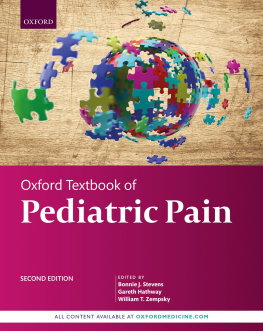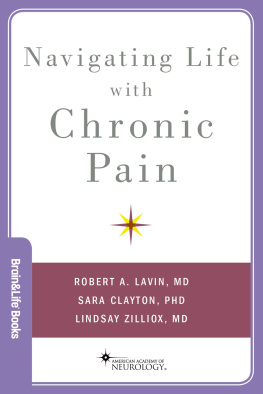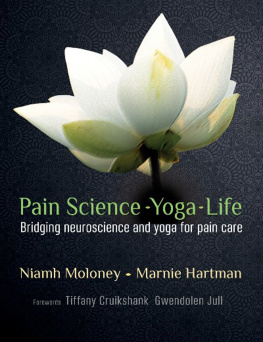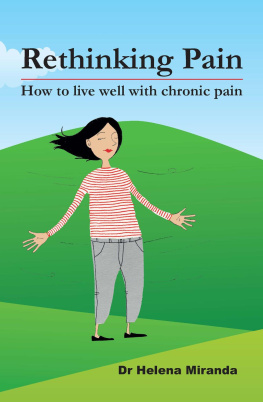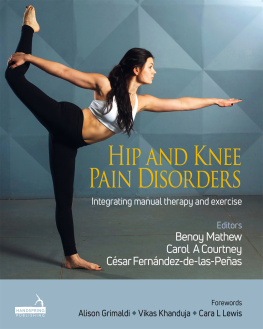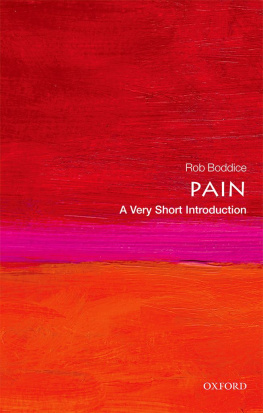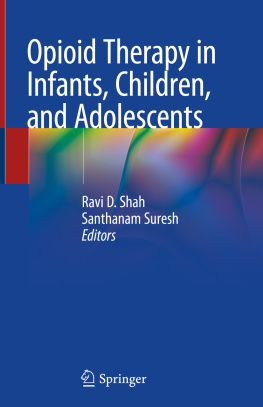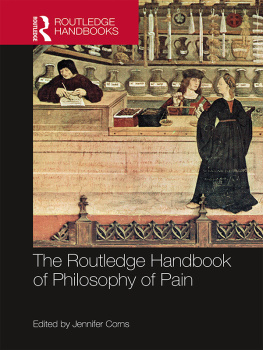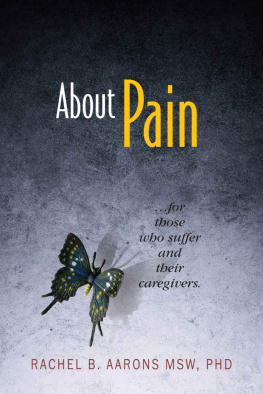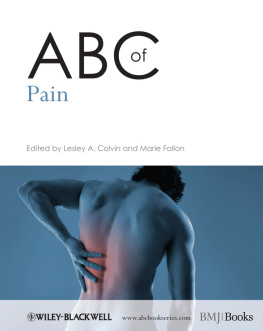Oxford Textbook of
Pediatric Pain

Great Clarendon Street, Oxford, OX2 6DP,
United Kingdom
Oxford University Press is a department of the University of Oxford. It furthers the Universitys objective of excellence in research, scholarship, and education by publishing worldwide. Oxford is a registered trade mark of Oxford University Press in the UK and in certain other countries
Oxford University Press 2021
The moral rights of the authors have been asserted
First edition published in 2014
Second edition published in 2021
Impression: 1
All rights reserved. No part of this publication may be reproduced, stored in a retrieval system, or transmitted, in any form or by any means, without the prior permission in writing of Oxford University Press, or as expressly permitted by law, by licence or under terms agreed with the appropriate reprographics rights organization. Enquiries concerning reproduction outside the scope of the above should be sent to the Rights Department, Oxford University Press, at the address above
You must not circulate this work in any other form and you must impose this same condition on any acquirer
Published in the United States of America by Oxford University Press
198 Madison Avenue, New York, NY 10016, United States of America
British Library Cataloguing in Publication Data
Data available
Library of Congress Control Number: 2020941564
ISBN 9780198818762
eISBN 9780192550798
Oxford University Press makes no representation, express or implied, that the drug dosages in this book are correct. Readers must therefore always check the product information and clinical procedures with the most up-to-date published product information and data sheets provided by the manufacturers and the most recent codes of conduct and safety regulations. The authors and the publishers do not accept responsibility or legal liability for any errors in the text or for the misuse or misapplication of material in this work. Except where otherwise stated, drug dosages and recommendations are for the non-pregnant adult who is not breast-feeding
Links to third party websites are provided by Oxford in good faith and for information only. Oxford disclaims any responsibility for the materials contained in any third party website referenced in this work.
Preface
Pain, and its treatment, continues to be an unsolved mystery for many children and their care providers. However, during the last 6 years we have increased our understanding of how pain in early life differs to that in maturity using a mixture of approaches from basic science, clinical science, and implementation science that is reflected in the 62 chapters of this second edition of the Oxford Textbook of Pediatric Pain. This new knowledge paints an exciting landscape on strategies to prevent and/or ameliorate pain for the children and families who suffer needless pain, and for healthcare providers, decision-makers, policymakers, and all those engaged in solving the mysteries of pain.
From basic science, we have an increasing appreciation of the role of non-neuronal cells in mediating pain responses in early life. We have increased our understanding of the role of glia in spinal pain processing in early life and have begun to understand how these macrophage-like cells are fundamentally uniqueundergoing markedly different phenotypic shifts than adult microglia. In early life, these cells mount largely anti-inflammatory responses rather than the proinflammatory ones seen in later life. Further research is emerging to understand the way in which this response occurs.
We are also becoming more aware of the lifelong consequences of pain in early life on the physiological response of individuals. We have known for some time that clinically induced painful injury can alter sensory thresholds in later life and have recently learned that this is also true in laboratory animals, thus allowing for the investigation of the mechanisms that underpin it. We have learned that global hypoalgesia following early life injury results from changes in the maturation of the descending pain control pathways from the brainstem and we have also seen how early life injury can prime microglia to alter their response to injury much later in life. Finally, we continue to learn more about the role of the brain in perceiving and modulating pain responses. The last 20 years have seen quantum leaps in our understanding of how the neonatal human brain perceives and processes tactile and painful information. Recently, we have seen how the areas of the brain that process sensory and affective components of pain in early life are very similar to those in the adult (with notable exceptions of the amygdala and orbitofrontal cortex), how brainstem pain control pathways function in early life to modulate pain perception, and how ensembles of neurons in the sensory cortices differentially encode noxious information versus adults.
From clinical science, we have seen how hospitalized neonates and infants continue to be exposed to multiple painful procedures daily and how each exposure to a painful event has both immediate and long-term consequences. Though we witness exponential expansion in the production and synthesis of evidence supporting the implementation of pharmacological, behavioral, and physical approaches to pain reduction, these strategies continue to be inconsistently applied. There have been reports where assessment is occurring in less than one-third of Neonatal Intensive Care Unit admissions and daily in only 10% of neonates. In the developing world, there continues to be reports of daily painful procedures such as peripheral cannula insertion and intramuscular injections with almost no infants receiving any analgesia. Of a multitude of validated infant pain assessment tools, and guidelines stipulating their use, consistent pain assessmentas a basis for treatmentis still severely lacking. Similarly, pain management for procedural pain, despite rigorous systematic reviews, remains less than optimal, with many effective treatments being omitted from caregiving. Continuous and persistent pain in infants remains poorly defined, assessed, and treated.
Hospitalized older children continue to undergo painful procedures for diagnostic and treatment purposes, often without optimal pain assessment or treatment. Studies indicate that up to a third of patients representing all age groups experience pain in the previous 24 hours, with about a quarter reporting moderate-to-severe pain. The majority of children in moderate-to-severe pain did not have a documented pain assessment, and evidence-based pharmacological and/or integrative (nonpharmacological) measures were not systematically administered to prevent or treat pain. Also, one in five children suffers from some form of chronic pain without sufficient access to system-wide resources, resulting in the costs of treatment-seeking adolescents with moderate-to-severe chronic pain upwardof US$20 billion annually in the US alone.
The explosion of clinical research that incorporates multiple methodological approaches and patient and family perspectives has continued to expand our knowledge of pain, and pain prevention and treatment, with notable advances in both acute and chronic pain. We are also learning the importance of the influence of culture and diversity in relation to pain assessment and treatment. Our understanding of the factors that may increase risk for the development of chronic pain, including adverse childhood events, gives us new targets for intervention. There has been a growth in research of web-based e-health interventions to allow youth to access pain self-management strategies, pain education, and cognitive behavioral therapies closer to home. There has been notable improvement in the use of multimodal pharmacological therapies in hospitalized children and youth with chronic pain (e.g., regional techniques, and use of adjunctive medications such as ketamine and lidocaine), as well as integrated pain management.

